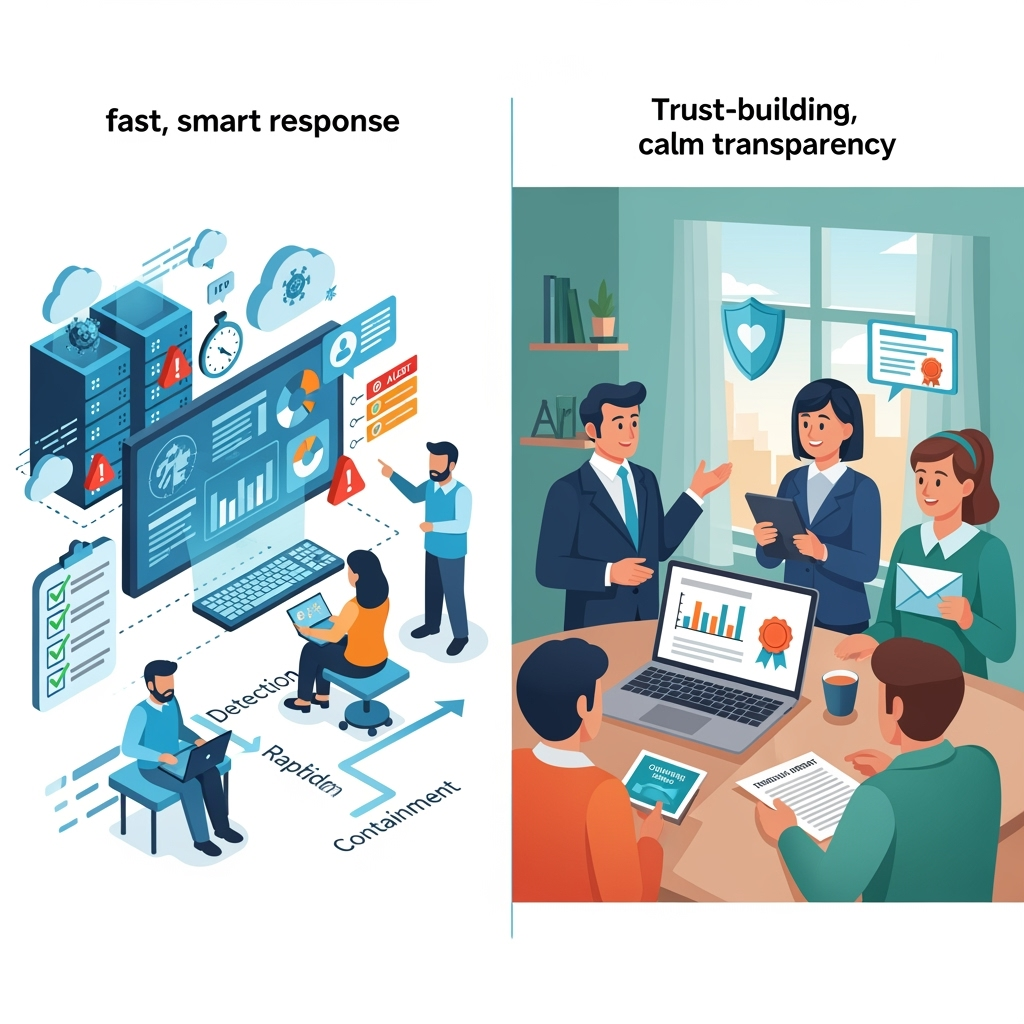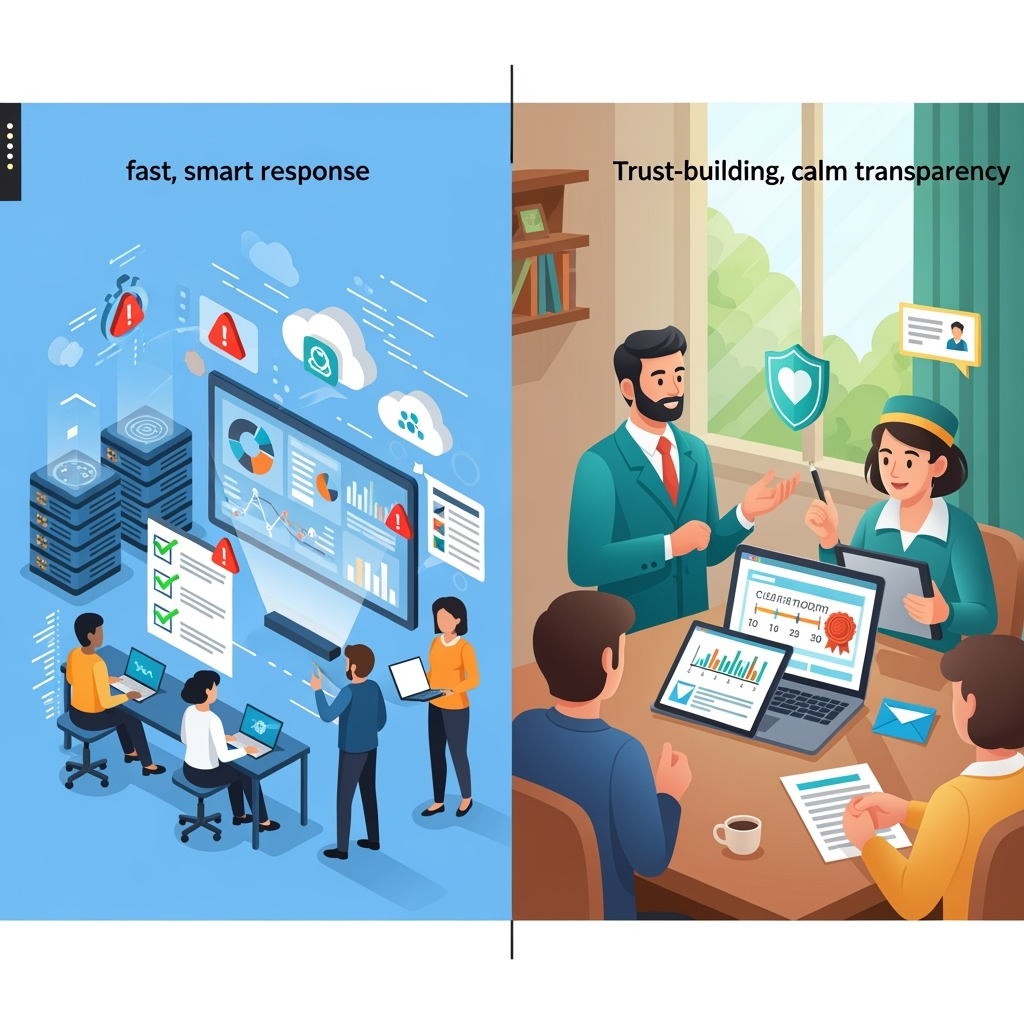When a data breach hits, the clock starts ticking. Your next moves can either turn chaos into control—or make things worse. The good news? With a clear plan and calm execution, you can contain damage, meet legal requirements, and even strengthen trust with customers and partners.
Here’s your action-ready playbook for responding to a data breach—steps, best practices, and the messaging that keeps stakeholders on your side.
What Counts as a Data Breach?
A data breach is any unauthorised access, disclosure, or loss of data—especially personal, financial, or confidential business information. It can stem from phishing, stolen credentials, misconfigurations, insider actions, vulnerable third parties, or lost devices.
Think: if someone got to data they weren’t supposed to, treat it as a breach.
The First 60 Minutes: Stabilise and Contain
- Confirm the incident
- Verify the breach with logs, alerts, and affected systems.
- Avoid tipping off attackers while you validate—don’t post publicly yet.
- Convene your incident response team
- Core roles: Incident lead, IT/SecOps, Legal/Compliance, PR/Comms, HR, and relevant business owners.
- Use out-of-band communications if email or chat may be compromised.
- Contain without destroying evidence
- Isolate affected endpoints, disable compromised accounts, block malicious IPs, and rotate keys—carefully.
- Don’t wipe systems yet; preserve memory images, logs, and artefacts.
- Start a forensic log
- Time-stamp every action: who did what, when, and why.
- You’ll need this for legal, regulatory, and post-mortem reviews.
The Next 24–48 Hours: Investigate, Assess, Decide
- Scope the breach
- What data types are affected? PII, PHI, PCI (credit cards), IP, credentials?
- Which systems, geographies, and vendors are involved?
- When did it start? Is it ongoing?
- Preserve evidence
- Capture disk images, memory dumps, network logs, cloud audit trails, and IAM changes.
- If you lack in-house forensics capacity, bring in a reputable IR firm.
- Eradicate the threat
- Patch exploited vulnerabilities, remove backdoors, rotate secrets, and harden IAM policies (MFA, least privilege).
- Validate that attacker access is fully removed.
- Risk assessment and regulatory mapping
- Map data types and user locations to regulatory obligations (e.g., GDPR, HIPAA, state breach laws, PCI DSS, POPIA, etc.).
- Determine notification triggers and deadlines. Many laws require notification “without undue delay”—some within 72 hours.

Communicate with Clarity: Who, What, When, How
- Notification strategy
- Internal stakeholders: executive team, board, employees (especially client-facing teams).
- External stakeholders: affected individuals, customers, partners, insurers, regulators, and (when appropriate) the public.
- What to say
- Be accurate, transparent, and concise. Avoid speculation.
- Include: what happened, what data was involved (if known), what you’ve done, how you’re helping, and what recipients should do next.
- Provide a support channel (email, hotline, help centre page).
Example notification structure:
- Headline: “Security Incident Involving Customer Data”
- What happened and when
- What information may have been involved
- What you’re doing to protect users (e.g., password resets, monitoring, credit protection)
- What you recommend users do (e.g., change passwords, watch for phishing)
- How to get help and stay updated
- Timing matters
- Hit regulatory deadlines.
- If facts are incomplete, issue an initial notice and promise updates as your investigation progresses.
Support Affected Individuals
- Reduce harm
- Force password resets where appropriate.
- Offer credit monitoring and identity theft protection if financial or identity data was exposed.
- Publish phishing guidance and security tips (e.g., don’t click links in suspicious emails claiming to be from your company).
- Make it easy to get help
- Stand up a dedicated FAQ page and support queue.
- Train support teams on consistent messaging and escalation paths.
Strengthen Your Defences Post-Incident
- Post-incident review (the blameless way)
- What happened, root cause(s), time to detect, time to contain, gaps in tooling/people/process.
- Turn findings into concrete improvements with owners and timelines.
- Security upgrades worth prioritising
- Identity: Enforce MFA everywhere, harden SSO, and rotate high-value credentials.
- Detection & response: Centralised logging, alert tuning, EDR/XDR, 24/7 monitoring.
- Data protection: Data classification, encryption at rest/in transit, DLP controls, key management hygiene.
- App and infra: Patch cadence, WAF, RASP, container/image scanning, IaC security, network segmentation.
- Human layer: Regular phishing simulations, secure engineering training, and least-privilege reviews.
- Third-party risk: Vendor security assessments, contract clauses for breach notification and minimum controls.
- Update your incident response plan
- Incorporate lessons learned, new playbooks (e.g., ransomware vs. credential stuffing vs. third-party breach), and contact trees.
- Run tabletop exercises quarterly to validate readiness.
Best Practices That Pay Off—Before Anything Goes Wrong
- Have a living IR plan with named roles, backups, and 24/7 contact info.
- Maintain a data inventory and classification—so you know what’s at risk.
- Log everything centrally and retain it long enough to investigate.
- Backups: test restores regularly; keep at least one immutable/offline copy.
- Principle of least privilege across users, services, and vendors.
- Security by design in SDLC: threat modelling, code scanning, and dependency management.
- Cyber insurance with clear incident response panel options.
Red Flags and Common Pitfalls to Avoid
- Deleting or altering compromised systems before forensics is complete.
- Under-communicating or delaying notices beyond legal timelines.
- Over-sharing technical details that help attackers or create liability.
- Assuming the breach is over after one fix—verify thoroughly.
- Forgetting third-party systems, shadow IT, or stale access keys.
Quick-Start Checklist
- Detect and validate the incident.
- Assemble IR team; communicate out-of-band if needed.
- Contain without destroying evidence.
- Preserve logs, images, and artefacts; begin forensics.
- Assess scope, data types, and regulatory obligations.
- Eradicate threat; rotate credentials and keys.
- Notify stakeholders with clear, helpful guidance.
- Support affected users with practical protections.
- Run a blameless post-mortem and implement fixes.
- Update the IR plan and train teams.
Turn a Crisis into Credibility
Breaches happen—even to the best. What separates resilient organisations is speed, honesty, and a disciplined response. Execute this playbook with empathy and precision, and you won’t just survive a breach—you’ll come out with stronger systems and stronger trust.
Want a tailored incident response checklist for your stack and regulations? Tell me your tech and data footprint and I’ll draft one.


Leave a Reply